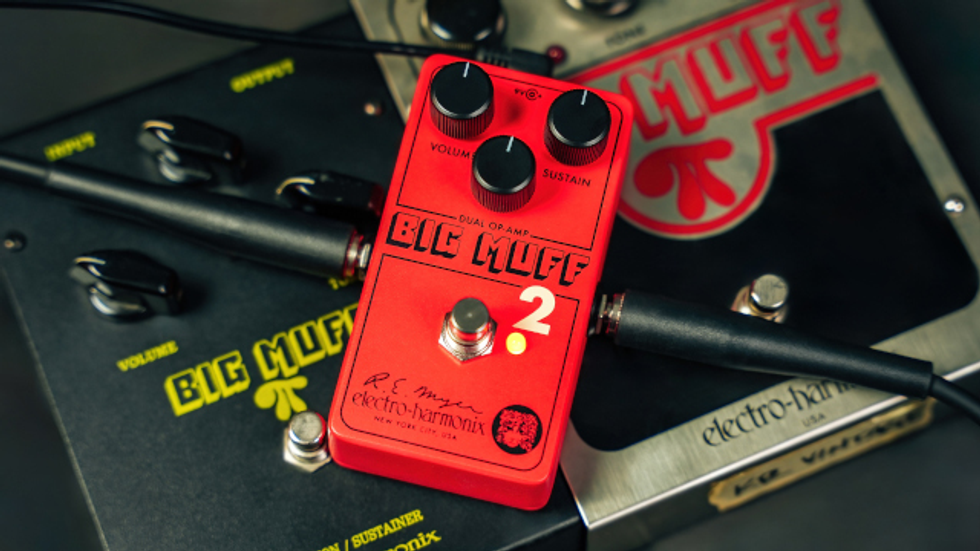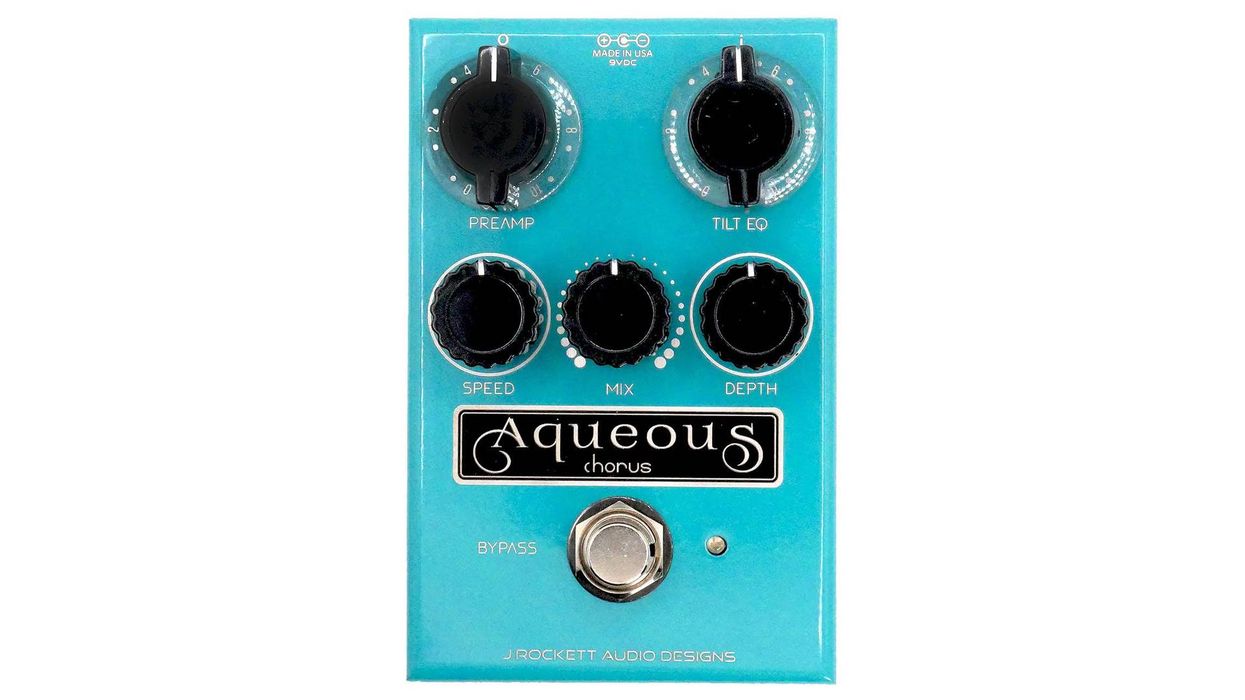Sam Beam was a painter and filmmaker who happened to write songs as a hobby for seven years before a friend loaned him a 4-track recorder. He went wild with the humble device in his home studio, producing, performing, and recording what was to become the first Iron and Wine album, The Creek Drank the Cradle, in 2002. Featuring acoustic guitars, banjo, and slide guitar, the album was immediately compared to the work of Nick Drake, Simon and Garfunkel, Neil Young, and John Fahey.
That same year, Beam recorded the song “The Trapeze Swinger” for the film In Good Company, and his version of the Postal Service’s “Such Great Heights” was featured in the film and soundtrack to Garden State. In 2005, Beam stepped away from Iron and Wine long enough to collaborate with the band Calexico—a band known for its trademark fusion of Southwestern rock, traditional Mexican music, and jazz—on the EP In the Reins. In 2007, I&W released a third full-length, The Shepherd’s Dog, which was produced by Brian Deck at his Chicago-based Engine studio. Deck added just the right amount of studio polish and encouraged Beam to explore synthesizers and effects to go beyond the acoustic-heavy sound of previous albums. The results were nothing short of stellar, and The Shepherd’s Dog was subsequently voted one of the year’s 10 best albums by Paste magazine.
Producer Brian Deck returned for this year’s Kiss Each Other Clean sessions, continuing the creative partnership that he and Beam have developed over the course of three albums. The comfort level and respect between Deck and Beam allows for a unique working relation- ship where they push each other to experiment, while still letting the songs naturally evolve in the studio. Not another hippy-dippy folk wannabe, Beam has become one of today’s greatest story tellers, crafting meticulous recordings that mingle memories of his parents’ record collection and hits heard scanning the car radio on family drives. With Kiss Each Other Clean, Beam again pushes Iron and Wine into new territory with layered textures and polyrhythmic sounds created with heavily processed guitars and synths. It’s an incredible mélange of folk, African, rock, country, and Jamaican musical traditions, all mixed up with ’60s and ’70s pop influences.
We recently spoke to Beam about his deceptively nonchalant approach to guitar playing and tones, his collection of cool old guitars and boutique amps, and why melody trumps all.
What aspects of your upbringing and childhood environment influenced the development of your sound?
Well, I grew up in the Carolinas, where there was a lot of country music around, and my parents were also big into classic ’60s Motown, so that’s what I heard a lot of as a kid. But I came up in the early ’80s, too, so New Wave was a big deal, skate punk was a big deal. By the time I was 12 or 13, I was just playing for a hobby, maybe an hour or two every now and then. It was just friends playing together at someone’s house. We weren’t doing any shows or anything. At 15, I started playing punk rock, because that was what I was listening to and that was what I could play, y’know—barre chords weren’t that hard to do. Learning complex chords structures took a lot longer. Over the years, I branched out and tried to learn everything, so I guess my tastes are all over the board, really.
What was your first guitar?
My dad had an acoustic guitar—I don’t remember what kind, but I remember the action was super-high and it was really hard to play. That’s what I learned on. Then my folks bought me a Strat-o-something copy, because that’s all we could afford. My amp was a little 15-watt practice amp that I beat to the ground. I remember my friend had a Peavey, and I thought that was cool.
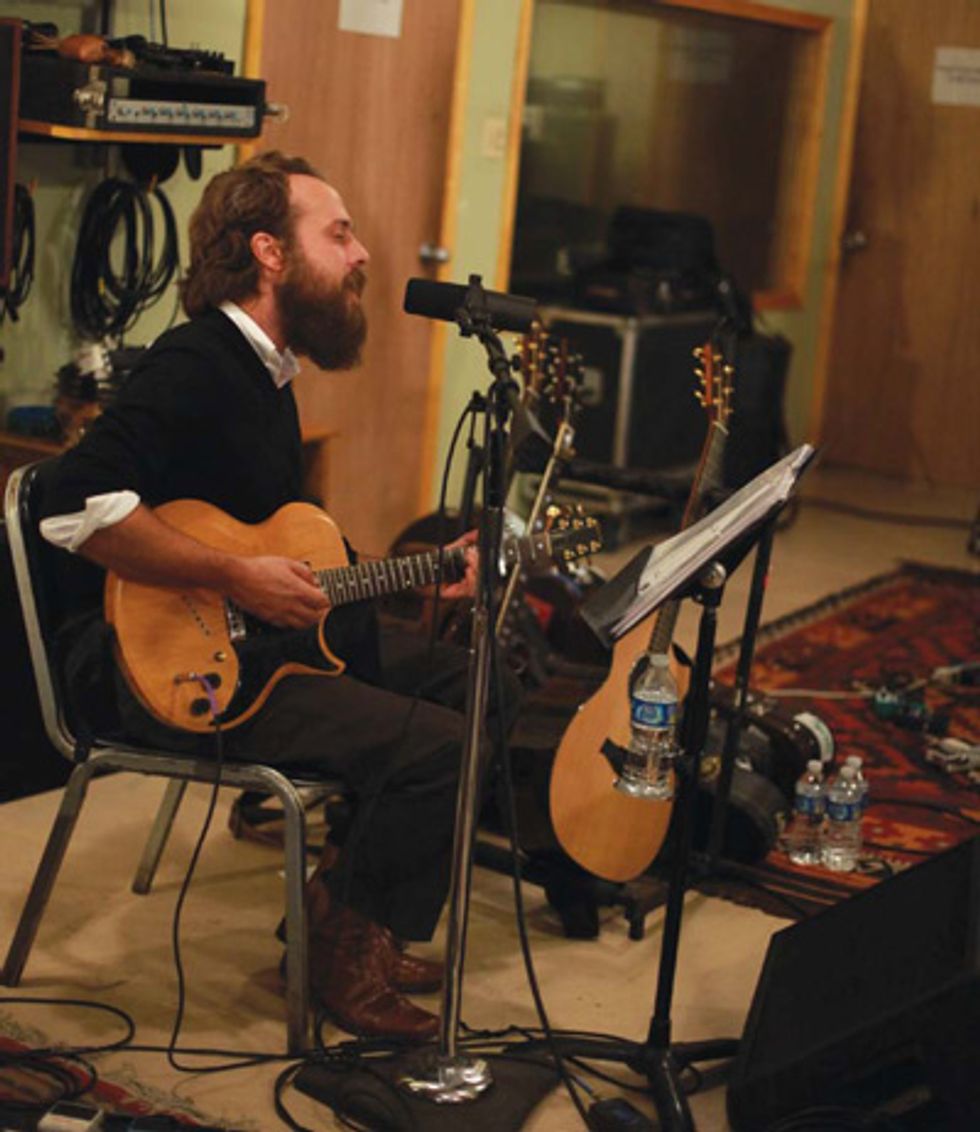
Sam Beam playing a late-’70s or early ’80s Gibson L-6S Deluxe during sessions at Clava Studios in Chicago. His guitar boat is stocked with a 1972 Gibson SG Standard (middle) and two Taylor flattops. Photo by Piper Ferguson
What was the path from skate punk to the more sensitive singer-songwriter thing?
It was a long one, let me tell ya! There were many years digesting the music of my youth and classics like the Beatles and Bob Dylan and working on my own style.
What was your writing process for the new album?
I write all the time. I have a pen and paper in my hands now. I don’t write with records in mind—at least in the early stages. I try to treat writing like a job, with a certain amount of discipline. When events come together to make a record, I sort through the stuff I’ve got and decide what’s ready to be taken to the next step—and, of course, see which ones fit together in a loose thematic thread. But if you write a little bit each day, you’d be surprised how many songs you can have in a year. I have to say, though, that my process is based more on rewriting than inspiration. It takes a long time to develop most of my songs—my first ideas are rarely the best ones.
After the writing phase, we started recording in April 2009, and I cut the basic rhythm tracks with the band in Chicago at Engine studio. I wanted to record the basic tracks with my band, because on the last album [2007’s The Shepherd’s Dog] we used a click track, and I think it suffered from that. We did the other half at my home studio, and then Brian mixed it at Engine. I would take parts home to flesh them out with different overdubs, adding parts and taking them away. I guess Brian and I treat songs like paintings, where we make some marks or throw some paint on, and then come back and do it again until they’re finished.
Do you think a record’s feel can suffer from using a click track?
Well, a click track doesn’t lack feel per se, but it definitely has a feel of its own, which wasn’t right for me.
What are your favorite tunings to write in?
I use DADGAD quite a bit, as well as open G [D–G–D–G– B–D]. On Kiss Each Other Clean, I used DADGAD on “Half Moon” and “Big Burned Hand.”
Do you bring several guitars onstage tuned to your open tunings, or do you just re-tune onstage between songs?
No, I usually have two guitars—one in standard tuning, and another in DADGAD. Sometimes, I’ll figure out how to play DADGAD songs in standard tuning, which is kind of fun.
Do you ever collaborate or do you prefer to write alone?
I mostly write alone, but I did an EP with Calexico back in 2005 called In the Reins, and that was a lot of fun and great creatively. So, yeah, I do like to collaborate, but the opportunity doesn’t come along that often.
What guitars did you use on Kiss Each Other Clean?
Oh man, my publicist said you were going to be asking me about guitars [laughs].
Don’t tell me you don’t like guitars?
I love guitars—each of them has songs in them! I just don’t have a proper inventory off the top of my head. They aren’t even all in one place. I know your readers would like specific setups, but I select tones because they serve the song, not because I’m trying to establish a certain guitar-and-amp setup that defines Iron and Wine.
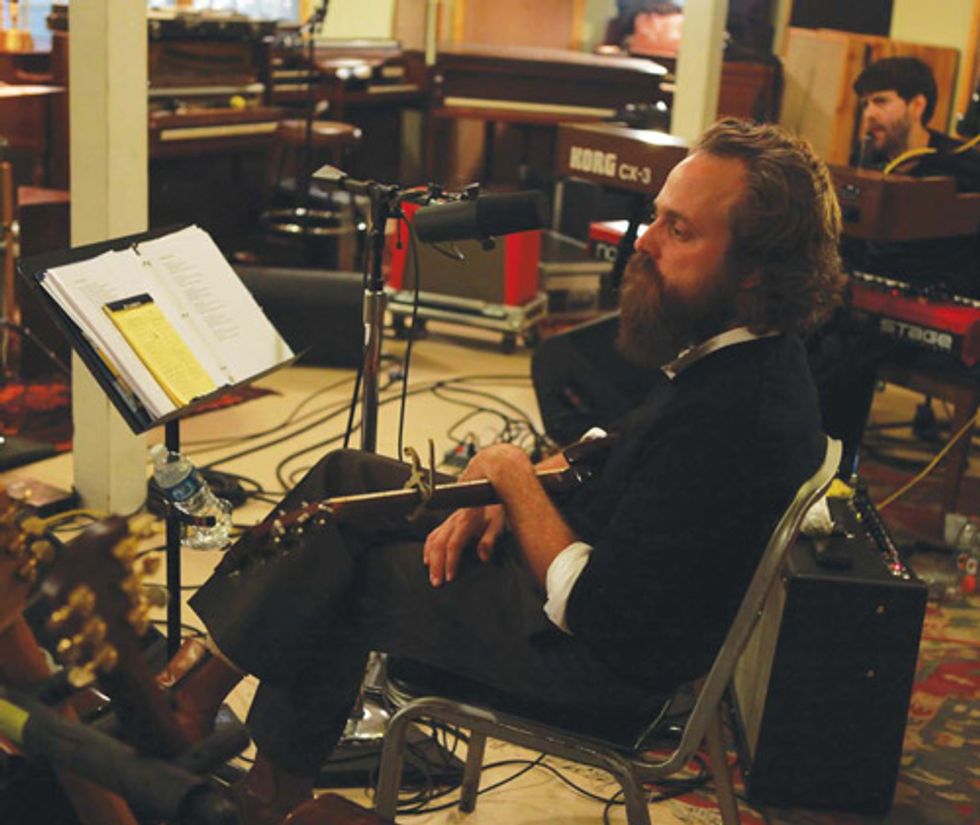
Beam, his ’72 SG, and a Fender Hot Rod DeVille 212 (right) rest between
takes at Clava Studios in Chicago. Photo by Piper Ferguson
Let’s talk about the tracks on the album and see if that jogs your memory.
I’ll do my best.
On “Walking Far from Home,” there’s a cool drone intro that sounds like an Ebow or some sort of Robert Fripper-y . . .
There really isn’t much guitar on that track. The drone is mostly processed piano and organ, but I think I did do a strummed acoustic guitar track through a Moogerfooger pedal as part of the drone.
The guitar on “Tree by the River” has a twangy, deliciously crispy overdrive. How did you get that sound?
It was a Gibson ES-335. It has humbuckers, but it can get a cool, almost Tele-like twang, too. The amp I used was built by Jesse Duke, a friend of mine in Austin, and it’s a big part of the sound. It’s a Fulton Webb 30 Watt, which has a ’60s Marshall channel and a tweed Deluxe channel. I flipped the half-power switch, turned it up loud, and that’s the sound it made.
“Half Moon” has a great mess of slide playing. Is that you?
No, it’s a friend of mine named Jim Becker playing slide on his Tele. He plays it with a volume pedal, so the volume swells sort of like a steel guitar. Actually, there are two tracks of slide. The other is me playing my ’57 Gibson ES-125 with a single P-90 at the neck. I love that guitar. I also played the chugging, blues-type rhythm on my early ’70s Strat through a tweed Fender Bassman.
I hear a Phillip Glass-type repetition going on in there, too.
Yes, there is. I did the arpeggio-type fingerpicking on a Gretsch Country Gentleman from Brian Deck’s Engine studio in Chicago. The warbly sound comes from a Moogerfooger pedal, again.
Do you use a claw-hammer or Travis-style fingerpicking technique?
I wish I knew how to do those styles [laughs]! I just use my thumb and index finger: The thumb plays the low end and the index finger does the higher stuff, which fills up a lot of space. The first thing I do when it comes time to overdub with the rest of the band is get rid of my original guitar track, because it usually doesn’t leave enough sonic space for the band.
“Rabbit Will Run” has a kalimba-sounding part that’s doubled on guitar. It sounds kind of like ’80s Peter Gabriel.
Wow, Peter Gabriel? Thanks for the compliment! That was a Jerry Jones JJ Original Shorthorn reissue—a really well-made copy of an old ’60s Danelectro. The lipstick pick- ups have enough of that tic-tac bass sound to fool you into thinking it’s a baritone guitar.
“Your Fake Name Is Good Enough for Me” sounds like finger tapping rather than picking.
No, its not finger tapping. It’s basically just me fingerpicking a blues riff on the Gretsch Country Gentleman. Then a clave track kicks in and it all sort of mixes together. I like throwing a bunch of different instruments together and processing them until you’re not sure which instrument is creating a particular sound and you can just sit back and enjoy the noise.
Besides the Fulton Webb, do you use any other amps?
Oh yeah. I have a Fender Tremolux from the ’60s that I used for its nice clean sound. I also have a little tweed Champ that I can crank for sustain. I also have an old tweed Bassman I used a lot, too. There are also tons of amps at Engine. I used an old Vox AC30 and Cambridge Reverb. There were a couple of blackface Fender Twins, a Super Reverb, and a ’67 Marshall Super Lead. I plugged into each of these at some point.
Do you mix it up with mic setups and techniques?
Brian Deck showed me a great mic’ing technique— a Shure SM57 dead center on the speaker cone and a Beyerdynamic M 160 off axis, but pointing at the cone. We used that setup on almost all the guitar tracks.
A lot of times, mixing genres yields horrible results—like country rap. But your work doesn’t sound incongruous. As a guy who got noticed as an acoustic player, what inspired you to start incorporating synths?
Well, just because I played acoustic guitar for the past several years doesn’t mean I haven’t listened to [pioneer- ing English electronic duo] Autechre and Radiohead and all that shit. I love all that stuff. I grew up in the ’80s in America, not on a mountain in Tibet! We dabbled with synths on the previous album, and this time we just figured, “Screw it—let’s do an album that’s mostly synth.”
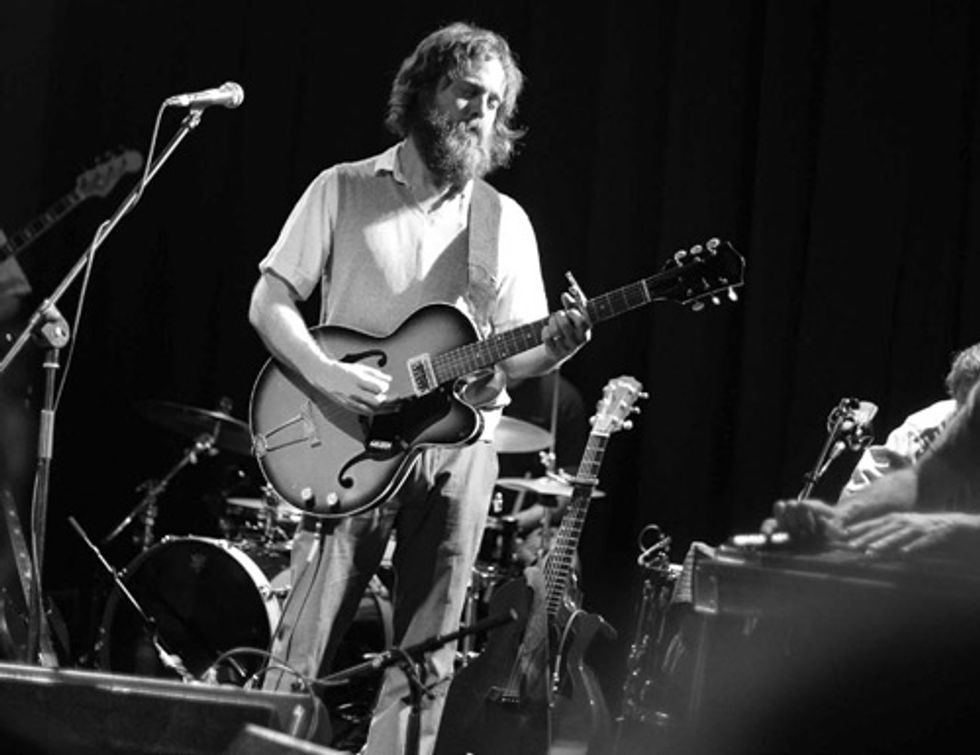
Beam onstage on March 20, 2008, with a vintage Gretsch hollowbody and a
Taylor acoustic waiting in the wings. Photo by Benjamin Millar
What keeps you working with producer Brian Deck?
Well, he likes me, and I like working with people that compliment me constantly [laughs]. We are friends, and he is a great person to bounce ideas off of. He tells me what he likes and what he doesn’t. We also have similar subversive ideas about what pop music should be.
It’s interesting that you say “subversive,” because the weird synth sounds you used on the album do seem to go against the usual stripped- down singer-songwriter troubadour norm—except for Beck.
[Laughs.] Yeah, Brian and I both like different types of music, so we try to fit it in there, one way or another. I really feel like I can take the songs and put whatever texture I want on them. If you believe in your melody, you can do whatever you like.
Sam Beam's Gearbox
Guitars
1957 Gibson ES-125T, Jerry Jones JJ Original Shorthorn reissue, Gibson ES-335TD, early ’70s Fender Stratocaster, 1972 Gibson SG Standard, Taylor acoustics
Amps
Fulton Webb 30 Watt, blackface Fender Tremolux, tweed Fender Bassman, tweed Fender Champ, Fender Hot Rod Deville 212
Effects
Moog Moogerfooger, Boss DD-3 delay, Boss TU-2 tuner
Strings and Picks
Elixir .010-.046 sets, “Whatever pick’s in the studio”











![Rig Rundown: Russian Circles’ Mike Sullivan [2025]](https://www.premierguitar.com/media-library/youtube.jpg?id=62303631&width=1245&height=700&quality=70&coordinates=0%2C0%2C0%2C0)








